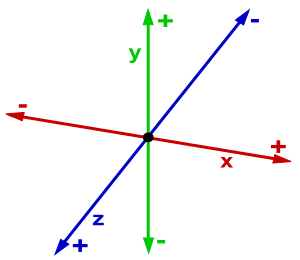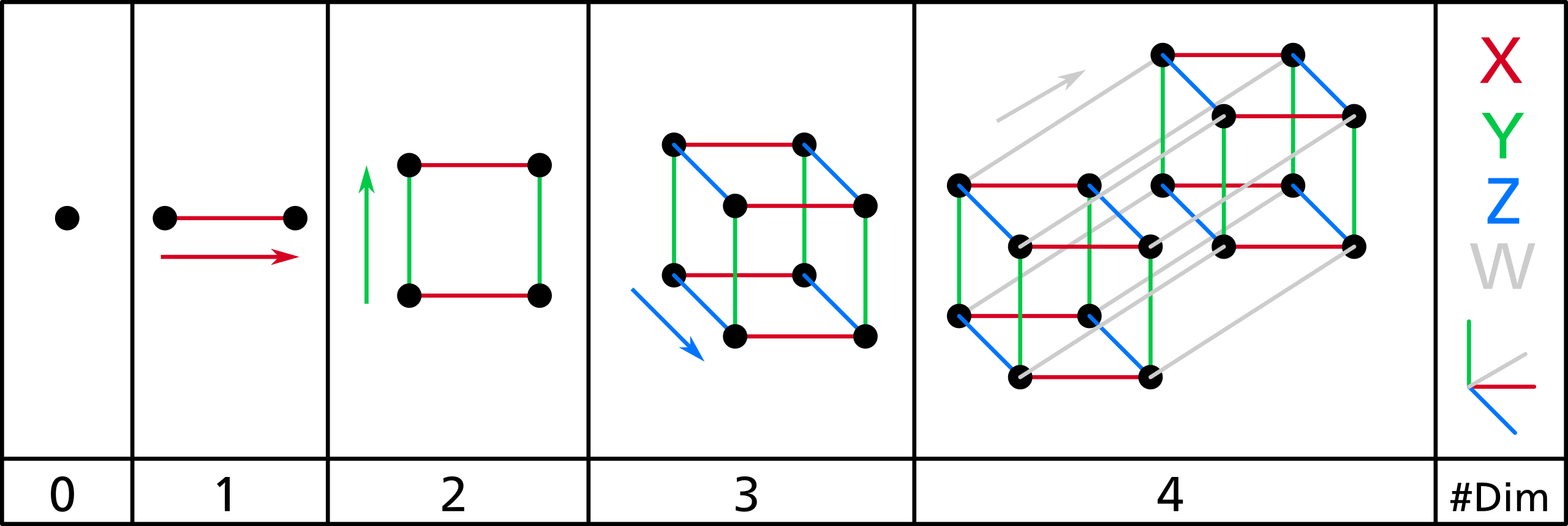Dragon's World
What is the fourth dimension? (It's not time)
In our regular world, you can move in 6 directions, or along 3 perpendicular axis: Up/down, forwards/backwards, and left/right. In the forth dimension, you can move along another axis, allowing you to move in 8 directions. This means that you can have 4 perpendicular lines. Pretty cool, right?
But wait, how is that possible?

The concept of 4 perpendicular lines might seem kinda absurd to you. You can try imagining that in your head all you want, but you just can't fit a fourth line in there. The problem is, you're thinking with the wrong mindset. Imagine a two-dimensional (flat) creature trying to understand our world. If you tell it that you can have 3 perpendicular lines, it would find THAT pretty absurd.
A 2d being can only see and imagine flat things. This causes an interesting phenomenon where when one interacts with an object from our world, they can only view and experience one slice of said object at a time. This slice is called a cross-section, and by moving that 3d object through the 2d being's viewing area, they can see different slices at different times, and get an idea of what the object is like, sorta like an MRI.
Rather than trying to fit the three parallel lines into its own world, the 2d being can imagine another direction that it cannot see all at once. Instead, it has to view different slices of these 3d objects at different points in time. That way, a third line can be at a 90 degree angle from the other lines, in time. There you have it: three perpendicular lines.

If that's a little confusing, imagine three perpendicular lines. Now imagine the MRI scan of them. First you have just a singular point for a little while. This is the first half of your third line. This point will stay, but then the other two lines appear for a split second, an infinitely small amount of time, and all of the lines have their singular intersection at a single point. Then you continue to see just the singular point for a little while -- the latter half of the third line.
How does this apply to the fourth dimension?
We can imagine the fourth dimension in relation to us by going down one dimension and imagining the third dimension in relation to the second. The fourth dimension can also be conceptualized through "MRI scans", but each slice is 3d instead of 2d. The parallel lines example is a little confusing, so let's think in terms of spheres.
If a sphere passes through the world of a 2d being, it would appear to the being as a small circle magically appearing, then getting bigger and bigger, before getting smaller again and disapearing. This is because a sphere is a bunch of circles next to eachother. We can sorta see this effect on the MRI gif, where at the end the cross-section gets smaller and smaller. This is because heads are also kinda round.
When a 4d sphere (called a hypersphere) passes through our world, we will also see different cross-sections of it. It will be a small sphere magically appearing, getting bigger, then smaller again, before shrinking to nothing.

Analogies like this can really help you understand the fourth dimension. They can't entirely explain it, and they certainly can't prove things, but they serve as a good introduction. Another type of analogy is moving a concept from (0d ->) 1D -> 2D -> 3D... and then to 4D. The best example of this is the hypercube analogy. A line is made of two dots, because in 1d space there are two directions. A square is made of four lines, because in 2d space there are four directions. A cube is made of six squares, because in 3d space there are six directions.
What is a 4d cube (a hypercube) made of? Well, there are 8 directions in 4d space. You may have noticed that each dimension used the shape of the dimension below it as sides (1d lines used 0d dots as sides, 2d squares used 1d lines as sides, and 3d cubes use 2d squares as sides). Combining these, you get: "A hypercube is made of eight cubes connected to eachother. This is because you can move in eight directions in 4d space."
Conclusion (for now)
I may expand this page in the future, but for now that is all that I am writing. The fourth dimension is insanely cool, and this explanation only scratches the surface. Here are some more links to check out:
Another great explanation, which delves into even more detail than I did.
A more mathematical approach to understanding the fourth dimension.